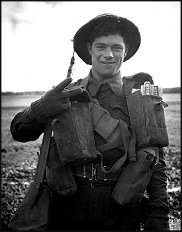Tripsrath - 1st Battalion Worcestershire prepare for attack
‘D’ Day for 'Operation Clipper' (18th November 1944) dawned bright and clear and frosty. The Companies of the Worcestershire Regiment emerged from the protection of their concrete air-raid shelters in Brunssum having prepared themselves for battle in all respects, including a well-attended church service on the previous day. At 10.30 hours the men clambered into their TCV’s (Troop Carrying Vehicles) and on the backs of tanks and moved slowly off towards the assembly area. Through the thick woods, along rough tracks specially cut by the Sappers, and aptly named route signs 'Bond Street', 'Regent Street', 'Dover Street', 'Strand', 'Saville Row' and 'Wyvern Road'.

Worcestershire Battalion route to Forming-Up-Point (18th November 1944)
(The area mark D is where the men debussed)
The Worcesters debussed east of Neiderbusch, slightly south of Gillrath, and dispersed amongst the trees. The sound of our Artillery, which had started again at 08.00 hours, could still be heard pounding the German positions. To the pleasant surprise of the men, ‘A’ Echelon was already there waiting for them with the first hot meal of the day, a most welcome sight.
After resting and enjoying their meal, tea and the usual rum ration, they waited for the order to move up to the start line, where the 7th Battalion Somerset L.I. had been earlier. The FUP (Forming-Up-Point) was in two huge sand quarries near the Gillrath brickworks by the Gillrath-Bauchem Road.
At 12.30 hours ‘B’ and ‘D’ Companies of the 7th Somersets L.I. crossed the start line and advanced across open fields towards their objective, the village of Niederheide.
Just after 13.00 hours the order to move came and the Worcesters marched from the wood out on to the Gillrath-Bauchem Road, were the British Press was much in evidence.
Captain Harold Hodge and Major Bryan Elder |
The attack was treated as a gala occasion by the press who milled up and down the column in their jeeps. Reporters with green labels on their shoulders and cameras in their hands were very much in evidence, and the Battalion, which by this time was quite use to the idea of making history, found a fresh thrill in the thought that it was about to become “News”. The results of their labours were featured in several of the weekly-illustrated papers. Captain Percy Huxter ( 2nd in command ‘A’ Company), remembers the occasion well; “We all lined up as though we were going to a football match, we walked across a field and we were told to wait on the edge of the field before the attack. There were some reporters there from the Worcester Evening News and Times and they were talking to us about the attack. When the attack started the press stayed behind.” Corporal William Gould (Signals Company) also remembered the men from the press; “They photographed us from all angles and interviewed the men. Years later I saw a picture of myself in the Picture Post leading a section of my platoon.” The adjacent photo, taken by the press, shows Private Forman of the Worcesters giving the ‘V’ sign at the FUP near Gillrath just before the attack went in. In the distance behind him you can see the woods at Niederheide, their first objective. Private Forman is well packed with ammo and the 2-inch mortar bombs are clearly seen in his chest pouch.
|
Lieut.-Col. R. Osborne-Smith |
Private Forman |
While waiting at the FUP, Lieut.-Colonel Osborne Smith, Worcester Commanding Officer, with a rifle slung over his shoulder and an encouraging look of confidence on his face, strolled around his troops and chatted with various people so as to ease the tension. Indeed, during the whole campaign his quiet courtesy to all ranks never deserted him. This was much appreciated by all the men.

Artillery Fire Plan for the attack and follow-up
(Louis Scully private collection)



